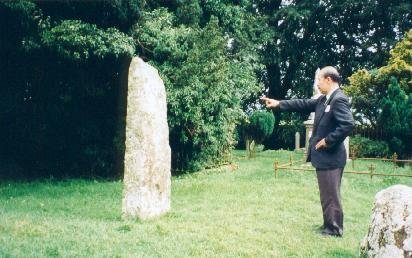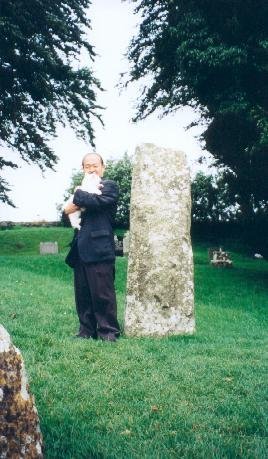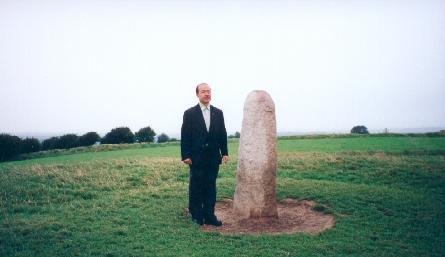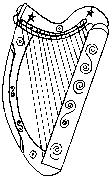
( Aerial view of Tara )
Tara the gateway to the Celtic spirit and
the Tuatha De Danaan, the people of shining light.
Tara shrouded in mystery and warmed by the cloak of great legends. Sitting quietly within the Boyne valley scene of great battle, seat of the Ard Ri high kings of Ireland who claim lineage through the sons of Miled back to Moses.
Such is the heart of Tara, rich in history, glorious in legend, tranquil in timeless beauty.
There are many legends surrounding Tara and the Boyne valley. One legend in particular is of great interest. The Sun Goddess Tea - pronounced Ta, hid in a cave depriving the world of light, the other Gods and Godesses then had to play music, dance and perform rituals to entice her out. She saw her own reflection and was intrigued by the beauty not realizing that it was herself and so she came out of the cave and light returned to the world.
"The Tuatha De Danaan "
The Tuatha De Danaan the people of shining light and guardians of the gateways to the Celtic otherworld arrived in Ireland surrounded in mystery and magic. The Lebor Gabala Erenn - The book of invasions describe them as people of great wisdom and beauty who hailed from four great cities where they learned science, craftsmanship and attained great wisdom from four great sages. From these cities they brought with them four magical gifts.
From Falias came
the Lia Fail - the Stone of Destiny.
From Gorious came
the Invincible Sword.
From Finias came
the Magical Spear.
From Murias came the Cauldron of the Dagda.
(The vessel of eternal knowledge)
(The vessel of eternal knowledge)
There is also reference in the Lebor Gabala, which says that they came direct from Heaven.
The Lia Fail - Stone of Destiny was held at Tara since time immemorial. The stone that is standing there now is not the true Lia Fail. It can however be used as a focal point because the ground on which it stands is sacred. The shape of the mounds laid out in spirals, the vista, a giant clock recording the stars against the backdrop of a vast horizon, the hosts of great warriors, of noble lords, of the High Kings and the Tuatha De Danaan, of the countless legends and of course of the timeless beauty that will always be Tara.
On the 23rd of August 1999. Grand master Shoto Tanemura arrived in Ireland for his first ever visit to perform an ancient ritual on the hill of Tara and to rekindle the flame. For those present from Ireland, England and Belgium it was a profound and deeply spiritual experience.
The morning of the 24th was clouded over as we stood in a circle facing an ancient stone in the graveyard, which is now the main entrance to the hill of Tara. We stopped here because Sensei said there was something wrong, the stone was too strong. Here Sensei performed the first ritual, chanting and using Kuji Kiri, Without warning a beautiful cat entered the circle. As the ceremony came to a close Sensei picked up the cat it purred loudly as it rubbed it's face against Sensei's.

|

|
||
|
Grand master ShotoTanemura
|
|||
|
and the white cat.
|
"The white animal
comes to give blessing like the white butterfly that leaves the mouth of the
dying Druid."
On the hill of Tara the Grand master stood on top of the Mound of the hostages a cave adorned with ancient carvings and symbols chanting and cutting the air facing each direction in turn and praying with cupped hands. Just watching was powerful but the true experience was what we could feel.
Before Sensei commenced with the main ceremony on the spiral mounds at Tara he bowed his head and prayed at the only other monument there, a stone dedicated to the memory of the 4500 men who died defending Tara in the 1798 rebellion. These men were known as the United Irishmen although they were made up of different religions, it was a moment of true reflection.

The Grand master described the Lia Fail
as not true but we could use it as a point of
focus.
"The Importance for now is Tara itself "
We walked a special pattern around the spiral mounds with our heads bowed in prayer as Sensei chanted and performed the sacred ceremony ending with each individual offering prayer to the light of wisdom. It is important to remember also that many of the later texts were subject to Christian influence. Later still to heavy Christian influence, which tried to destroy much of the older beliefs and lesson the power of our legends. Such as the deep-rooted belief in our Celtic being that the underlying spirituality has survived to this day. We still have our place names intact since the time of the Gods this alone gives us a link to pre-history, to our ancient past.
I am the child of poetry, Poetry the child of reflection ,
Reflection the child of meditation, Meditation the child of lore,
Lore the child of great knowledge, Great knowledge the child of intelligence,
Intelligence the child of understanding, Understanding the child of wisdom,
Wisdom the child of three Gods of Danu.
Reflection the child of meditation, Meditation the child of lore,
Lore the child of great knowledge, Great knowledge the child of intelligence,
Intelligence the child of understanding, Understanding the child of wisdom,
Wisdom the child of three Gods of Danu.
( "From the Irish colloquy of
the Ancients" )







